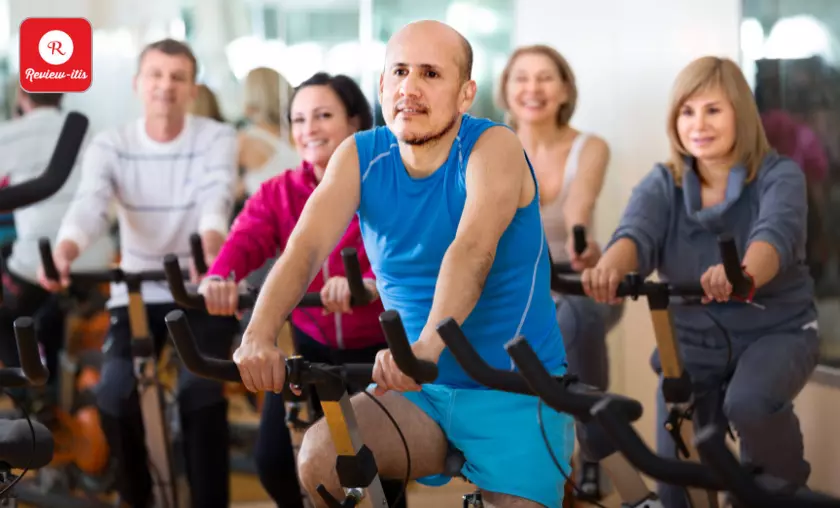Let’s set the record straight on the effects of chronic cardio and its potential impact on weight gain. Some individuals have claimed that engaging in cardio exercises can lead to unwanted weight gain. However, it’s important to note that this notion is not entirely accurate. Cardio exercises themselves do not directly result in fat accumulation. Weight gain occurs when the energy intake exceeds the energy expenditure in the body.
In certain circumstances, incorporating chronic cardio exercises alongside other behaviors may increase the likelihood of gaining body fat. It’s crucial for everyone to understand that the effects of chronic cardio on weight gain are multifaceted and depend on various factors. While it is true that our previous article mentioned that “aerobic exercise is a fat trap,” it is essential to clarify that this refers to specific situations and should not be interpreted as cardio exercises being solely responsible for weight gain.
Table of Contents
The Surprising Effects of Chronic Cardio
- Based on Boutcher’s 2011 review, regular aerobic exercise has minimal impact on reducing body fat.
- Sprint intervals, on the other hand, have shown to be more effective for achieving better results in fat reduction.
- Prolonged engagement in cardio exercises can lead to the loss of lean muscle mass, decreasing the body’s resting calorie expenditure, as noted by Westcott in 2009.
- If calorie intake is not adjusted accordingly, this decrease in resting calorie expenditure can potentially lead to fat gain.
- Boutcher’s 2009 review highlights that short-term, aerobic exercise studies aimed at reducing body fat often yield less fat loss than anticipated, leading to disappointing results.
- A comprehensive meta-analysis conducted by Miller in 1997, analyzing 493 studies, reveals that modifying one’s diet is a far more effective approach to reducing body fat, especially among overweight individuals.
- The primary objective of aerobic exercise is to train the body to achieve optimal efficiency, adapting to utilize the least amount of oxygen and energy for the greatest amount of work.
- Unfortunately, this adaptation does not directly contribute to fat loss.
Witness this effect in Williams’ 2006 survey of 12,568 runners. Only those who increased their weekly distance or running speed over the 9-year study avoided fat gain. Conversely, those who maintained or slightly increased mileage and intensity ended up with larger waistlines.
This evidence merely scratches the surface, indicating that cardio is not effective for losing body fat. It raises the question: Why do some people gain fat despite doing cardio, and how can this be avoided? Discover the answers and achieve the benefits of exercise—optimal body composition, abundant energy, and a stress-free workout program—with the following rules.
Effective Aerobic Cardio for Overweight Beginners

When you initially incorporate cardio into your routine, several factors relevant to fat loss come into play:
- Calorie burning occurs during the workout itself as well as during the recovery period that follows.
- Your body enhances its ability to burn body fat and transitions more efficiently between fat burning and carbohydrate burning—a beneficial adaptation for fat loss.
- Improved insulin sensitivity allows your body to utilize blood sugar more effectively.
Depending on the intensity & duration of your workouts (often around 75 percent of maximal heart rate for 40 minutes in research studies), you can anticipate losing approximately 1 to 2 kg of fat within a span of 3 to 4 months, assuming your diet remains unchanged.
A comprehensive review of studies revealed that cardio interventions lasting at least 15 weeks typically resulted in an average fat loss of around 1.5 kg. It’s worth noting that individuals who are already lean tend to experience less fat loss compared to those who are overweight.
Body Adaptation: Cardio’s Fat Loss Decline

To maintain the same metabolic benefits, you have two options: increase the intensity and train at a faster pace, or increase the distance covered.
Consider this: Scientists estimate that in order to achieve a consistent fat loss of approximately 1 pound per week in active individuals, one would need to engage in moderate-intensity cardio for upwards of 1 hour every day of the week, according to calorie balance equations.
However, even with this extensive volume of exercise, there will be diminishing returns in the long term due to potential muscle mass loss. Additionally, the repetitive stress from exercise could disrupt hormone balance. Furthermore, it’s important to note that calorie balance equations have limited applicability in real-life situations.
It’s crucial to find a sustainable and balanced approach to exercise and fat loss that takes into account individual needs and goals rather than solely relying on extreme exercise volumes.
Cardio Can Increase Hunger and Fat Gain

It is worth noting that people often tend to consume more food when engaging in cardio exercises. Moreover, misconceptions about the ideal way to “fuel” exercise have resulted in individuals consuming high-glycemic foods before, during, and after workouts, thereby hindering fat burning.
Regarding light and moderate-intensity cardio activities like walking, jogging, or cycling, the depletion of energy stores and muscle damage is insignificant. Consequently, there is no need for additional protein or carbohydrates, as they can undermine a calorie deficit. Furthermore, both protein and carbs stimulate the release of insulin, which is not ideal for maximizing fat loss.
Interestingly, evidence suggests that some individuals reward themselves for exercising by indulging in carbohydrate-rich and high-fat foods, ultimately leading to fat gain. It’s essential to be mindful of dietary choices in response to exercise and maintain a balanced nutrition and fat loss approach.
Cardio + Calorie Restriction: Weight Cycling

When individuals initially embark on weight loss efforts, they may experience a reduction in both fat and muscle mass. However, the fat tends to return once they increase their calorie intake and discontinue dieting. Additionally, the lost lean muscle is often replaced by fat.
This unfavorable shift in body composition leads to a decrease in the number of calories burned at rest and increases the risk of developing various diseases. For instance, individuals who engage in cardio exercises while repeatedly cycling through diets in hopes of shedding fat tend to experience higher levels of inflammation & an increased risk of heart disease compared to those who maintain a stable weight without dieting or exercise.
High Cortisol Hinders Fat Loss in Cardio

When cortisol levels remain high consistently, several effects take place:
- Insulin resistance develops within cells, leading to inflammation and hindered access to body fat for energy expenditure.
- Hormones responsible for regulating hunger can become imbalanced. Individuals experiencing heightened stress and elevated cortisol levels tend to have a 15 percent higher ghrelin (hunger-triggering hormone) and a 15 percent lower leptin (appetite-suppressing hormone) compared to those with normal cortisol levels.
- High cortisol levels drive individuals towards consuming high-sugar foods in an attempt to replenish the depleted neurotransmitter serotonin, which occurs during chronic stress.
- Growth and testosterone (T) are suppressed due to fat accumulation, particularly in the abdominal and trunk regions.
Considering these factors, if you have high cortisol and aim to reduce body fat, the following actions are recommended:
- Prioritize stress reduction methods, focusing on improving sleep quality, considering appropriate supplementation, engaging in meditation or relaxation techniques, and incorporating enjoyable activities into your routine.
- Opt for a diet that emphasizes lower glycemic index foods and includes whole, nutrient-dense options.
- Consider strength training as your primary exercise mode rather than relying solely on cardio workouts. Strength training helps balance cortisol levels with other hormones like GH and T and improves insulin sensitivity.
Cortisol + Cardio: Fat Gain Likelihood

Engaging in cardio exercises alone can result in an increase in cortisol levels.
Typically, this temporary rise in cortisol is not concerning, especially for healthy individuals who lead sedentary lifestyles and start incorporating cardio workouts. In such cases, insulin sensitivity and fat burning tend to improve, often leading to some fat loss.
However, when the cortisol surge from daily cardio is combined with an already elevated cortisol curve due to stress, it creates a scenario that can trap fat. This is more likely to occur during high-intensity or prolonged cardio sessions. Additionally, intense training while in a fasted state can also lead to elevated cortisol levels, whereas engaging in low-intensity activities like walking or casual exercise is less likely to pose a problem.
Even if you regularly perform cardio exercises, high cortisol levels can result in fat gain. This can occur if you consume more calories than intended or become less physically active throughout the day, leading to a reduced overall calorie burn. It’s essential to be mindful of your cortisol levels and consider lifestyle factors that may influence fat accumulation.
Women’s Long-Term Cardio Fat Loss Challenge

Several factors contribute to the increased likelihood of this scenario:
- Weight cycling resulting from a combination of calorie restriction and cardio leads to a gradual loss of muscle mass and a decrease in metabolic rate. This effect is particularly prominent in women, as they typically start with lower muscle mass compared to men.
- Women may be more susceptible to experiencing elevated cortisol levels as a response to repetitive training stress due to the delicate nature of their hormone balance. Excessive training stress can cause cortisol production to take precedence over the utilization of pregnenolone for progesterone synthesis.
- As a consequence of the imbalanced cortisol production, estrogen and testosterone levels are reduced. Maintaining a balanced ratio of estrogen and testosterone is vital for optimal metabolic health in women.
Considering these factors, it becomes evident that women engaging in weight cycling, excessive training stress, and imbalanced hormone levels may face challenges in achieving optimal metabolic health and fat utilization. It is essential to take a holistic approach to address these concerns and focus on maintaining a balanced hormone profile while considering individualized strategies for exercise and nutrition.
Cardio Interferes with Muscle Building

It is widely acknowledged in sports science that when endurance athletes incorporate weightlifting into their training regimen, they experience increased strength and the size of Type II muscle fibers. However, they rarely observe significant gains in muscle mass. In fact, adding strength training often leads to a more favorable body composition for endurance performance, including reducing body fat.
A recent study provides insight into this phenomenon. Researchers conducted a strength training program involving young untrained men (Strength group) and elite cyclists (Cyclists). The Strength group did not perform any cardio exercises, while the Cyclists maintained their regular aerobic training routine.
The results revealed that the Strength group gained approximately 1 kg of muscle, whereas the Cyclists showed no significant increase. Additionally, the Strength group exhibited a 50 percent greater increase in quad and hamstring cross-sectional area compared to the Cyclists.
Scientists speculate that aerobic cardio exercises may suppress muscle-building pathways and promote catabolism, thereby inhibiting muscle development. Moreover, the high volume of exercise required for both cardio and strength training may contribute to elevated cortisol levels, further impairing muscle growth.
Hence, if your goal is to build muscle, which is highly effective for reducing body fat and maintaining long-term weight management, it is advisable to avoid steady-state cardio exercises and focus on incorporating strength training into your routine.
Interval Training: Efficient Fat Loss with Muscle Building

Many studies highlight the superiority of various high-intensity training over steady-state cardio for fat loss. Consider the following reasons:
- More Efficient Calorie Burning: High-intensity training, such as sprints, circuit training, strongman workouts, and even moderate intervals, allows you to burn more calories in a shorter amount of time. In just 25 minutes of intense intervals, you can burn more calories than you would during double that time with traditional cardio.
- Enhanced Post-workout Energy Expenditure: Following high-intensity training, your body experiences a heightened energy expenditure during the 24-hour recovery period. This is due to the increased energy demands required to restore metabolic balance and eliminate waste products accumulated during the workout.
- Muscle-building Potential: High-intensity training activates genes involved in protein synthesis, promoting muscle building. This leads to a more favorable hormonal environment post-workout, characterized by elevated growth hormone (GH), testosterone, and cortisol levels. By engaging in interval training, you can preserve and even build lean muscle mass, thereby improving your metabolic rate.
Various forms of high-intensity training surpass steady-state cardio for fat loss due to their ability to burn more calories in less time, elicit a more substantial post-workout energy expenditure, and promote muscle development through favorable hormonal responses.
Conclusion
The notion that chronic cardio is making you fat is only partially accurate. While there are certain circumstances in which cardio exercise, particularly steady-state cardio, may not be the most effective approach for fat loss, it is important to consider individual factors and goals. High-intensity training, such as intervals and strength training, can offer superior results in terms of calorie burning, post-workout energy expenditure, and muscle-building potential.
However, it is crucial to strike a balance and tailor your exercise routine to your specific needs and preferences. Understanding the interplay between cardio, intensity, nutrition, and overall lifestyle is key to achieving optimal body composition and long-term fat loss success.
FAQs
Does doing cardio lead to fat gain?
Contrary to popular belief, chronic cardio does not directly cause fat gain. The accumulation of body fat occurs when the energy consumed exceeds the energy expended. Cardiovascular exercise can play a role in calorie burning, but its impact on fat loss depends on various factors such as intensity, duration, and overall energy balance.
Why do some people gain fat despite doing cardio?
While cardio exercise can be beneficial for overall health and fitness, certain factors may contribute to fat gain despite engaging in regular cardio routines. These factors include improper nutrition, excessive calorie intake, hormone levels (such as cortisol) imbalances, and inadequate recovery. Understanding the interplay between exercise, diet, and lifestyle factors is crucial for achieving desired fat loss results.
Are there more effective alternatives to chronic cardio for fat loss?
Yes, there are alternatives to chronic cardio that have been shown to be more effective for fat loss. High-intensity training, such as interval and strength training, can increase calorie burn, increase post-workout energy expenditure, and promote muscle growth. These forms of exercise can help optimize body composition and metabolic rate, leading to more sustainable fat loss outcomes.
Can chronic cardio lead to muscle loss?
Chronic cardio, particularly steady-state cardio performed at moderate intensities and for prolonged durations, may contribute to muscle loss over time. This can occur due to the catabolic effects of excessive cardio exercise on muscle tissue. It’s important to incorporate strength training exercises that stimulate muscle growth alongside cardio workouts to preserve muscle mass.
How can I maximize fat loss while incorporating cardio?
Focusing on a comprehensive approach to optimize fat loss while including cardio in your fitness routine is essential. Incorporate a combination of high-intensity interval training, strength training, and moderate-intensity cardio sessions. Additionally, pay attention to proper nutrition, ensuring a balanced diet that supports your energy needs and promotes fat burning. Individualize your approach based on your goals, preferences, and body’s response to different exercise modalities.
For more amazing articles related to Health, & Fitness, Checkout Now with a click & click. Respectively.
To read more similar articles, click here.
Thanks for visiting our Website. If you appreciate our work, kindly show us some support in our comments section. 🙂